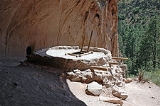
Kiva
Encyclopedia
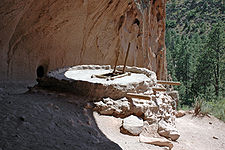

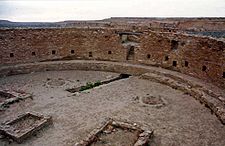
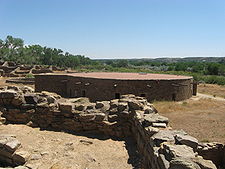
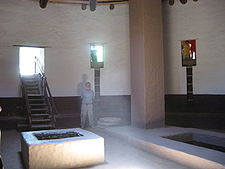
Pueblo people
The Pueblo people are a Native American people in the Southwestern United States. Their traditional economy is based on agriculture and trade. When first encountered by the Spanish in the 16th century, they were living in villages that the Spanish called pueblos, meaning "towns". Of the 21...
for religious rituals, many of them associated with the kachina
Kachina
A kachina is a spirit being in western Pueblo cosmology and religious practices. The western Pueblo, Native American cultures located in the southwestern United States, include Hopi, Zuni, Tewa Village , Acoma Pueblo, and Laguna Pueblo. The kachina cult has spread to more eastern Pueblos, e.g....
belief system. Among the modern Hopi
Hopi
The Hopi are a federally recognized tribe of indigenous Native American people, who primarily live on the Hopi Reservation in northeastern Arizona. The Hopi area according to the 2000 census has a population of 6,946 people. Their Hopi language is one of the 30 of the Uto-Aztecan language...
and most other Pueblo peoples, kivas are square-walled and underground, and are used for spiritual ceremonies
Ceremony
A ceremony is an event of ritual significance, performed on a special occasion. The word may be of Etruscan origin.-Ceremonial occasions:A ceremony may mark a rite of passage in a human life, marking the significance of, for example:* birth...
.
Similar subterranean rooms are found among ruins in the American southwest, indicating ritual or cultural use by the ancient peoples of the region including the Ancient Pueblo Peoples
Ancient Pueblo Peoples
Ancient Pueblo People or Ancestral Pueblo peoples were an ancient Native American culture centered on the present-day Four Corners area of the United States, comprising southern Utah, northern Arizona, northwest New Mexico, and southern Colorado...
, the Mogollon and the Hohokam
Hohokam
Hohokam is one of the four major prehistoric archaeological Oasisamerica traditions of what is now the American Southwest. Many local residents put the accent on the first syllable . Variant spellings in current, official usage include Hobokam, Huhugam and Huhukam...
. Those used by the ancient Pueblos of the Pueblo I Era
Pueblo I Era
The Pueblo I Era, from AD 750 to 900, was the first period in which Ancient Pueblo People began living in pueblo structures and realized an evolution in architecture, artistic expression, and water conservation...
and following, designated by the Pecos Classification
Pecos Classification
The Pecos Classification is a division of all known Ancient Pueblo Peoples culture into chronological phases, based on changes in architecture, art, pottery, and cultural remains. The original classification dates back to consensus reached at a 1927 archæological conference held in Pecos, New...
system developed by archaeologists, were usually round, and generally believed to have been used for religious and other communal purposes.
Evolution of the Kiva
When designating an ancient room as a kiva, archaeologists make assumptions about the room's original functions and how those functions may be similar to or differ from kivas used in modern practice. The kachinaKachina
A kachina is a spirit being in western Pueblo cosmology and religious practices. The western Pueblo, Native American cultures located in the southwestern United States, include Hopi, Zuni, Tewa Village , Acoma Pueblo, and Laguna Pueblo. The kachina cult has spread to more eastern Pueblos, e.g....
belief system appears to have emerged in the Southwest at approximately AD 1250, while kiva like structures occurred much earlier. This suggests that the room's older functions may have been changed or adapted to suit the new religious practice.
As cultural changes occurred, particularly during the Pueblo III
Pueblo III Era
The Pueblo III Era, AD 1150 to 1350, was the third period, also called the "Great Pueblo period" when Ancient Pueblo People lived in large cliff-dwelling, multi-storied pueblo, or cliff-side talus house communities...
period between 1150 and 1300, kivas continued to have a prominent place in the community. However, some kivas were built above ground. Kiva architecture became more elaborate, with tower kivas and great kivas incorporating specialized floor features. For example, kivas found in Mesa Verde were generally keyhole shaped. In most larger communities, it was normal to find one kiva for each five or six rooms used as residences. Kiva destruction, primarily by burning, has been seen as a strong archaeological indicator of conflict and warfare among people of the Southwest during this period.
Fifteen top rooms encircle the central chamber of the vast Great Kiva at Aztec Ruins National Monument
Aztec Ruins National Monument
The Aztec Ruins National Monument preserves ancestral Pueblo structures in north-western New Mexico, United States, located close to the town of Aztec and northeast of Farmington, near the Animas River...
. The room's "... purpose is unclear . . . Each had an exterior doorway to the plaza. . . . Four massive pillars of alternating masonry and horizontal poles held up the ceiling beams, which in turn supported an estimated ninety-five-ton roof. Each pillar rested on four shaped stone disks, weighing about 355 pounds apiece. These discs are of limestone, which came from mountains at least forty miles away." (A Trail Guide to Aztec Ruins, 4th printing:WNPA, 2004).
After 1325 or 1350, except in the Hopi
Hopi
The Hopi are a federally recognized tribe of indigenous Native American people, who primarily live on the Hopi Reservation in northeastern Arizona. The Hopi area according to the 2000 census has a population of 6,946 people. Their Hopi language is one of the 30 of the Uto-Aztecan language...
region, the ratio changed from 60 to 90 rooms for each kiva. This may indicate a religious or organizational change within the society, perhaps affecting the status and number of clans among the Pueblo people. The use of the kiva was for men and boys only.
See also
- Clown societyClown societyClown society is a term used in anthropology and sociology for an organization of comedic entertainers who have a formalized role in a culture or society.-Description and Function:...
- False KivaFalse kivaFalse Kiva is a human-made stone circle of unknown origin in a cave in a remote area of the Canyonlands National Park, which is located in U.S. state of Utah...
- FogouFogouA fogou or fougou is an underground, dry-stone structure found on Iron Age or Romano-British defended settlement sites in Cornwall. Fogous have similarities with souterrains or earth-houses of northern Europe and particularly Scotland including the Orkney Islands...
- Pit-housePit-houseA pit-house is a dwelling dug into the ground which may also be layered with stone.These structures may be used as places to tell stories, dance, sing, celebrate, and store food. In archaeology, pit-houses are also termed sunken featured buildings and are found in numerous cultures around the world...
- SipapuSipapuSipapu, a Hopi word, is a small hole or indentation in the floor of kivas used by the Ancient Pueblo Peoples and modern-day Puebloans. It symbolizes the portal through which their ancient ancestors first emerged to enter the present world....
- SouterrainSouterrainSouterrain is a name given by archaeologists to a type of underground structure associated mainly with the Atlantic Iron Age. These structures appear to have been brought northwards from Gaul during the late Iron Age. Regional names include earth houses, fogous and Pictish houses...
- Koshare Indian MuseumKoshare Indian MuseumThe Koshare Indian Museum is a registered site of the Colorado Historical Society in La Junta, Colorado. The building, located on the Otero Junior College campus, is a tri-level museum with an attached kiva that is built with the largest self-supporting log roof in the world...
External links
- La Kiva tradicional de Oscar Freire

